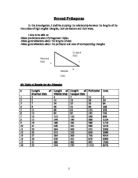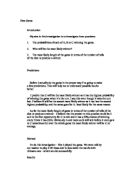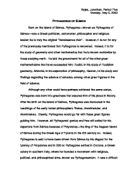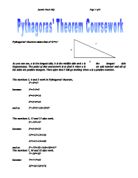Beyond Pythagoras
Mahmoud Elsherif Beyond Pythagoras P.1 Pythagoras Theorem is a2+b2= c2 'a' is being the shortest side, 'b' being the middle side and 'c' being the longest side (hypotenuse) of a right angled triangle. The numbers 3,4,5 satisfy this condition and so 32+ 42=52 Because 32= 3*3=9 42=4*4=16 52=5*5=25 32+ 42=52 9+16=25 25=25 This proves Pythagoras Theorem goes with the right angled triangle with the numbers 3,4,5. Next I shall prove that Pythagoras's Theorem applies to 5,12,13 right angled triangle. 52+122=132 Because 52= 5*5=25 22= 12*12=144 32= 13*13=169 Mahmoud Elsherif Beyond Pythagoras P.2 This satisfies the Theorem of Pythagoras's goes with these numbers 5,12,13. Finally I shall prove that Pythagoras's Theorem applies to 7,24,25 right angled triangle. 72+ 242=252 Because 72= 7*7=49 242= 24*24= 576 252=25*25=625. So a2+b2=c2 72+242=252 49+576=625 This proves Pythagoras Theorem goes with the right angle triangle with the sides 7,24,25 Shortest Side Middle Side Longest Side 3 4 5 5 2 3 7 24 25 9 40 41 1 60 61 3 84 85 Mahmoud Elsherif Beyond Pythagoras P.3 I shall find the prediction of the shortest side first. 3,5,7 It goes up in 2 so in my conclusion so it will become 3,5,7,9,11,13 Now I will find the difference between them. The difference is 2 Next I shall find the prediction of
Beyond Pythagoras
BEYOND PYTHAGORAS MATHS COURSEWORK INTRODUCTION Pythagoras was a Greek mathematician and philosopher. He lived in 400 BC and was one of the first great mathematical thinkers. He spent most of his life in Sicily and southern Italy. He had a group of follows who went around and thought other people what he had taught them who were called the Pythagoreans. Pythagoras himself is best known for proving that the Pythagorean Theorem was true. The Sumerians, two thousand years earlier, already knew that it was generally true, and they used it in their measurements, but Pythagoras proved that it would always be true. The Pythagorean Theorem says that in a right triangle, the sum of the squares of the two right-angle sides will always be the same as the square of the hypotenuse (the long side). A2 + B2 = C2 Pythagoras theorem can also help in real life. Here is an example: Say you were walking though a park and wanted to take a short cut. With Pythagoras's theorem you could work out exactly how long you would have to walk though the grass, rather then talking the long route by walking on the paths. PLAN I am going to investigate the three triangles I have been given. They are all right-angled triangles, with 3 sides, all different lengths. The three triangles satisfy the Pythagoras theorem. The theorem states that the hypotenuse side (longest side) must equal the 2 shorter
Beyond Pythagoras
Beyond Pythagoras In this investigation, I shall be studying the relationship between the lengths of the three sides of right angled triangles, their perimeters and their areas. I aim to be able to: -Make predictions about Pythagorean triples -Make generalizations about the lengths of side -Make generalizations about the perimeter and area of corresponding triangles My Table of Results for the Triangles n Length of Shortest Side Length of Middle Side Length of Longest Side Perimeter Area 3 4 5 2 6 2 5 2 3 30 30 3 7 24 25 56 84 4 9 40 41 90 80 5 1 60 61 32 330 6 3 84 85 85 546 7 5 12 13 240 840 8 7 44 45 300 224 9 9 80 81 380 710 0 21 220 221 460 2310 1 23 264 265 552 3036 2 25 312 313 650 3900 3 27 364 365 756 4914 4 29 420 421 870 6090 5 31 480 481 992 7440 6 33 544 545 122 8976 The reason I used certain triples in my table (for example there is also another triple for 9 as the shortest side which has 12 as the middle side length and 15 as the hypotenuse) is because they followed the pattern I was looking at. Even though some of the other triple combinations might have worked, I chose the ones out of them which went best with the other combinations. The 9,40,41 triple has a difference of 1 between its middle and longest side lengths, which is what the other triples
Beyond Pythagoras
Daniel Cook 10R Beyond Pythagoras: Year 10 GCSE Coursework I am going to study Pythagoras' theorem. Pythagoras Theorem is a2 + b2 = c2. 'a' being the shortest side, 'b' being the middle side and 'c' being the longest side (hypotenuse) of a right angled triangle. For example, I will use 32 x 42 = 52 . This is because: 32 = 3 x 3 = 9 42 = 4 x 4 = 16 52 = 5 x 5 = 25 So.. 9 +16 = 25 For this table, I am using the term a, b, b + 1 Triangle Number (n) Length of shortest side Length of middle side Length of longest side Perimeter Area 3 4 5 2 6 2 5 2 3 30 30 3 7 24 25 56 84 4 9 40 41 90 80 5 1 60 61 32 330 6 3 84 85 83 546 7 5 12 13 240 840 8 7 44 45 296 224 Formulas Shortest side = 2n + 1, n being the triangle number Middle side = 2n2 + 2n. This is because: Triangle Number 1 = 2 x 2 2 = 3 x 4 3 = 4 x 6 4 = 5 x 8 = 2n2 + 2n 5 = 6 x 10 6 = 7 x 12 7 = 8 x 14 8 = 9 x 16 Longest side = 2n2 + 2n + 1 Perimeter = A + B + C Area = A x B x 0.5 Box Methods Shortest² = (2n + 1) ² 2n +1 2n 4n² 2n +1 2n = 4n² + 4n + 1 Middle² = (2n² + 2n)² 2n² +2n 2n² 4n4 4n³ +2n 4n³ 4n² = 4n4 + 8n³ + 4n² Longest² = (2n² + 2n + 1)² 2n² +2n +1 2n² 4n4 4n³
Pythagorean triplets
Introduction We are to investigate the conditions and theory of Pythagorean triplets. Pythagoras' theorem states: in any right angled triangle, the square on the hypotenuse is equal to the sum of the squares on the other two sides. For numbers to be Pythagorean triplets they have to satisfy the condition: a2 + b2 = c2 This may be rearranged to give the a2 = c2 - b2 or b2 = c2 - a2, which are useful when calculating one of the shorter sides. A simple example of this is these numbers: 3 , 4 , 5 Because 32 = 3 * 3 = 9 42 = 4 * 4 = 16 52 = 5 * 5 = 25 32 + 42 = 9 + 16 = 25 = 52 This is the 1st Pythagorean Triple Another example is: 5 , 12 , 13 Another Example is: 7 , 24 , 25 We can now tell that numbers in the Pythagorean triplets have to be integers and we can now work out the perimeter and area of the triangles. To work out the perimeter we use the condition: a + b + c = units st triplet - 3 + 4 + 5 = 12 units 2nd triplet - 5 + 12 + 13 = 30 units 3rd triplet - 7 + 24 + 25 = 56 units To work out the area we use the condition: 1/2 * a * b = square units st triplet - 1/2 * 3 * 4 = 6 square units 2nd triplet - 1/2 * 5 * 12 = 30 square units 3rd triplet - 1/2 * 7 * 24 = 84 square units Length of Shortest side Length of middle side Length of longest side Perimeter Area 3 4 5 2 6 5 2 3 30 30 7 24 25 56 84 We can now put
Towers of Hanoi Investigation
Introduction Our course work is called the towers of Hanoi. We were asked to have x number of discs and move them to a different place in the least number of moves possible. There are two other places you can move them to. This is what it looks like with 4 discs. You have to move all of the discs to either B or C, they have to be in the same order. While moving the discs you can not put a bigger disc on top of a smaller one. We are to try with different numbers of discs and see if you can find a rule or a pattern Number of discs and its moves Disc . 1-B 2 Discs 2. 1-B 3. 2-C 4. 1-C 3 Discs . 1-B 2. 2-C 3. 1-C 4. 3-B 5. 1-A 6. 2-B 7. 1-B 4 Discs . 1-B 2. 2-C 3. 1-C 4. 3-B 5. 1-A 6. 2-B 7. 1-B 8. 4-C 9. 1-C 0. 2-A 1. 1-A 2. 3-C 3. 1-B 4. 2-C 5. 1-C 5 Discs . 1-B 2. 2-C 3. 1-C 4. 3-B 5. 1-A 6. 2-B 7. 1-B 8. 4-C 9. 1-C 0. 2-A 1. 1-A 2. 3-C 3. 1-B 4. 2-C 5. 1-C 6. 5-B 7. 1-B 8. 2-B 9. 3-A 20. 1-C 21. 2-A 22. 1-A 23. 4-B 24. 1-B 25. 2-C 26. 1-C 27. 3-B 28. 1-A 29. 2-B 30. 1-B 6 Discs . 1-B 2. 2-C 3. 1-C 4. 3-B 5. 1-A 6. 2-B 7. 1-B 8. 4-C 9. 1-C 0. 2-A 1. 1-A 2. 3-C 3. 1-B 4. 2-C 5. 1-C 6. 5-B 7. 1-A 8. 2-B 9. 1-A 20. 3-A 21. 1-C 22. 2-A 23. 1-A 24. 4-B 25. 1-B 26. 2-C 27. 1-C 28. 3-B 29. 1-A 30. 2-B 31. 1-B 32. 6-C 33. 1-C 34. 2-A 35. 1-A 36. 3-C 37. 1-B 38. 2-C 39. 1-C 40.
Beyond Pythagoras - Year 10 Maths Coursework
Beyond Pythagoras - Year 10 Maths Coursework By Nadia House 10G The numbers 3, 4 and 5 satisfy the condition 3²+4²=5², Because 3²= 3x3 =9 4²= 4x4 =16 5²= 5x5 =25 And so... 3²+4² (=9+16) = 25 (=5²) I now have to find out if the following sets of numbers satisfy a similar condition of: Smallest number² + Middle number² = Largest number² (S² + M = L²) a) 5, 12, 13 5² + 12² = 13² ~ (25 + 144 = 169) b) 7, 24, 25 7²+24² = 25² ~ (49 + 576 = 625) Here is a table containing the results: Short Side Middle Side Long Side 3 4 5 5 2 7 24 25 I looked at this table and noticed that there was only a difference of 1 between the length of the middle side and the length of the longest side. I already know that the Smallest number² + Middle number² = Largest number². So I know that there will be a connection between the numbers written above. The only problem is that it is obviously not: Middle Side² + Large Side² = Small Side² Because, 12² + 13² = 144 + 169 = 313 and 5² = 25 The difference between 25 and 313 is 288 which is far to big, so this means that the equation I want has nothing to do with 3 sides squared. I will now try 2 sides squared. M² + L = S² = 12² + 13 = 5² = 144 + 13 = 25 = 157 = 25 This does not work and neither will 13², because it is larger than 12². There is also no point in squaring the largest
Dice Game Maths Investigation
Dice Game Introduction My aim in this investigation is to investigate three questions: 1. The probabilities of each of A, B or C winning the game. 2. Who will be the most likely winner? 3. The most likely length of the game in terms of the number of rolls of the dice to produce a winner. Predictions Before I actually do the game in the proper way I'm going to make a few predictions. This will help me to understand possible results better. I predict that C will be the most likely winner as it has the highest probability of winning the game when it's his turn. I say this even though it takes its turn last. I believe B will be the second most likely winner as it too has the second highest probability; and the same goes for A- least likely for the same reason. As for the most likely length of game in terms of the number of rolls of the dice to produce a winner - I believe that the answer to this question could be 3 as it is the first opportunity for C to win and it has a 50% chance of winning every throw it has (3/6). Obviously A and more so B will win before it even gets to C sometimes but over the whole game the most likely winner will be C on average. Method To do this investigation - first I played the game. We were told by our teacher to play it 30 times and to take down the results with ultimate care - which we did successfully.
Pythagoras of Sámos.
PYTHAGORAS OF SÁMOS Born on the island of Sámos, Pythagoras-known as Pythagoras of Sámos-was a Greek politician, astronomer, philosopher and religious leader; he is truly the original "Renaissance Man". However, it is not for any of the previously mentioned that Pythagoras is renowned. Indeed, it is for his study of geometry and other mathematics that he is known worldwide by those studying math. He laid the groundwork for all of the other great mathematicians that have succeeded him: Euclid, in his study of Euclidian geometry, Aristotle, in his exploration of philosophy, Newton, in his study and findings regarding the science of calculus, among other great figures in the field of science. Although any other could have perhaps achieved the same status, Pythagoras was born into greatness that assured him of his place in history. After his birth on the island of Sámos, Pythagoras was instructed in the teachings of the early Ionian philosophers Thales, Anaximander, and Anaximenes. Clearly, Pythagoras would go far with these great figures guiding him. However, all Pythagoras' genius and free will called for his departure from Sámos because of Polycrates-the king of the Aegean island of Sámos during the Greek Age of Tyrants in the 6th century BC. Indeed, Pythagoras is said to have been driven from Sámos by his disgust for the tyranny of Polycrates and in 530 BC
Pythagorean Theorem Coursework
Pythagoras' theorem states that a²+b²=c² As you can see, a is the longest side, b is the middle side and c is the longest side (hypotenuse). The point of this coursework is to find b when a is an odd number and all of the sides are positive integers. Then after that I will go looking when a is a positive number. The numbers 3, 4 and 5 work in Pythagoras' theorem, 3²+4²=5² because 3²=3×3=9 4²=4×4=16 5²=5×5=25 and so 3²+4²=9+16=25=5² The numbers 5, 12 and 13 also work, 5²+12²=13² because 5²=5×5=25 12²=12×12=144 13²=13×13=169 and so 5²+12²=25+144=169=13² The numbers 7, 24 and 25 also work, 7²+24²=25² because 7²=7×7=49 24²=24×24=576 25²=25×25=625 and so 7²+24²=49+576=625=25² 3, 4 and 5 Perimeter= 3+4+5=12 Area= 1/2 ×3×4=6 5, 12 and 13 Perimeter= 5+12+13=30 Area= 1/2 ×5×12=30 7, 24 and 25 Perimeter= 7+24+25=56 Area= 1/2 ×7×24=84 From the first three terms I have realised that: - * a increases by 2 each time * a is equal to the formula ×2+1 from n * b is always even * c is always odd * c is always +1 of b * b=(a×n) + n I have also added 2 more terms using what I think are my formulae. 'n' 'a' 'b' 'c' Perimeter Area 3 4 5 2 6 2 5 2 3 30 30 3 7 24 25 56 84 4 9 40 41 90 80 5 1 60 61 32 330 Here are my formulas. They are formulas on how to get from n to all of the











